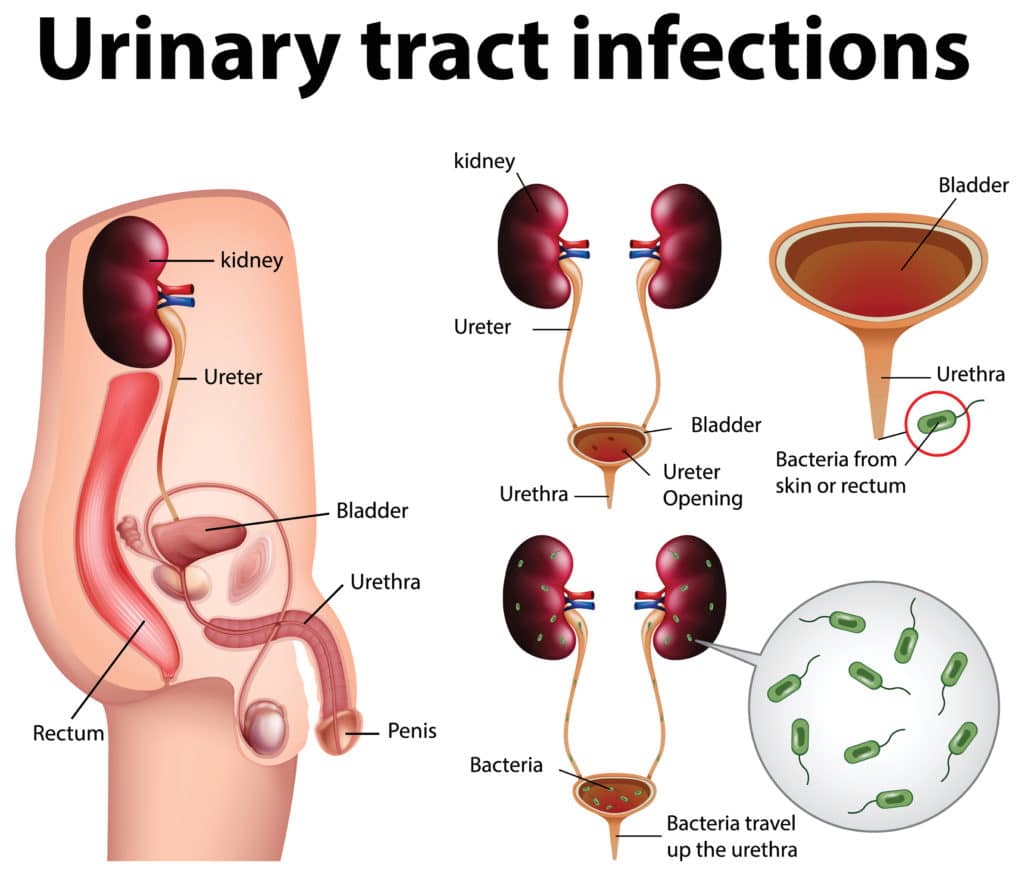What is UTI?
The urinary tract consists of two kidneys, two ureters, a urinary bladder, urethra and prostate. An individual is said to have UTI if there is an infection anywhere along the urinary tract.

UTI versus bladder infection/ kidney infection
Infection of the kidney is called pyelonephritis. Infection confined to the bladder is cystitis, if it is confined to the urethra, it is called urethritis. Infection confined to the prostate is called prostate.
UTI vs yeast infection
The urinary tract is different from the genital tract which is affected by yeast infection. Yeast infection or thrush is caused by an overgrowth of germs in the genitals. The genital tract which is also called the reproductive system consist of the vagina, cervix, uterus, fallopian tubes and ovaries in females. In men, the prostate, urethra, testes and penis make up the genital tract.
Causes of UTI
Germs (bacteria) gain access into the urinary tract and cause UTI. The access route is most often through the urethra. The germs then climb upwards into the urinary bladder, ureters and/ or the kidneys to cause infections.
There are certain conditions that may increase an individual’s risk of getting UTI. These include being female, pregnant, use of spermicidal creams and sexual intercourse (particularly 1st intercourse or intercourse with a new partner). Infection of the urinary bladder following intercourse is termed ‘honeymoon cystitis.’ Other risk factors for UTI in women are alteration in the normal vaginal environment /secretions due to prolonged use of antibiotics, use of some hormonal contraceptives or douching.
Risk factors for UTI in men include anal sex, urethral obstruction resulting from increased size of the prostate especially in men over 50 years old and lack of circumcision.
Urethral strictures, stones anywhere along the urinary tract, having a urethral catheter (a tube to drain urine from bladder) in the place, procedures involving inserting instruments into the urinary tract, residual urine in the bladder, neurogenic bladder (bladder with abnormal nerve supply that has lost sensation and ability to contract for complete emptying during urination or to relax and store urine) are all risk factors for urinary tract infection.
Conditions that reduce immunity such as uncontrolled diabetes mellitus, prolonged use of steroids and HIV infections also predispose to UTI.
Symptoms of UTI
The symptoms of UTI include:
- Frequent passing of urine
- Painful urination
- Blood in urine
- Foul-smelling urine
- Cloudy urine
- Fever
- Nausea and /or vomiting
- Diarrhoea
- Abdominal pain and/or flank pain
- Inability to withhold the urge to pass urine
UTI in males versus females
Females are more prone to having UTIs because of the way the female urinary tract is designed. The female urethra is short and this makes it easier for germs to get to the urinary bladder to cause infections. Furthermore, the female urethra is very close to the vagina hence it is at risk of being infected during sexual intercourse; in addition, the anus is in close proximity to the urethra and faecal matter containing infectious bacteria may invade the urinary tract through contact with the urethra. In contrast, males have a longer urethra and a urethral opening that is a good distance away from the anus.
UTI is therefore more common in females than males. In men however, UTIs are uncommon in young healthy circumcised males. An individual born with malformation of the urinary tract is at higher risk of UTI.
Is UTI a sign of pregnancy?
The Pregnant state is associated with lowered immunity. This is natural way the body works in order to prevent the immune system from perceiving the baby as foreign and getting rid of it. In addition, hormonal changes in pregnancy increase the risk of UTI in pregnancy. A pregnant woman is therefore at a higher risk of having a UTI. The best way to confirm pregnancy is by doing a pregnancy test at with urine or blood.
Will UTI go away on it’s own?
Once bacteria gain access into the urinary tract, it begins to birth more germs that occupy that area of the urinary tract. A certain number of germs have to be present to cause an infection; moreso, if this number is not reached and the germs are washed away during urination or die off on account of the environment that is unconducive for growth, then there would be no infection.
On the other hand, the number of bacteria required to cause an infection may be reached rapidly and eventually the germs may move to other areas of the tract to cause more serious infections that may no longer be limited to only one site. However, the spread of the infection may be nipped in the bud when treatment is instituted promptly.
The body has various processes and ways by which it protects itself from being invaded by germs. Each organ system has its own unique protective mechanisms. The urinary system protects itself by producing acidic urine which is unconducive for the growth of germs; the washing out effect of urine as it flows through the urinary tract when an individual urinates protects against infections as well. The urinary bladder is covered by a slippery layer which also makes it difficult for germs to remain and grow in the bladder.
How is UTI diagnosed?
UTI may be diagnosed clinically in a person who has the typical symptoms of UTI. It may also be diagnosed by urine tests such as urinalysis using dipsticks, urine microscopy and culture. Ultrasound scan may also be done to make the diagnosis or confirm either the diagnosis, cause/ risk factors or both.
Treatment of UTI
UTI is treated with either oral or injection antibiotics depending on the type, gender and risk factors. For those in whom a risk factor for recurrence is found in the course of investigations (tests), these are treated alongside. Uncomplicated UTIs such as UTI in females are treated for a few days with oral antibiotics. Complicated UTI for example UTI in a man, prostatitis, pyelonephritis and UTI associated with sepsis is treated with injectable antibiotics for several days to weeks.
How can UTI be prevented?
For females:
- Pass urine immediately after intercourse and whenever you have a full bladder.
- Avoid prolonged (and self-prescribed) use of antibiotics
- Avoid use of spermicide if you are prone to recurrent UTI
For men
- Circumcision
- Get treatment for any obstruction of the urinary tract such as prostate enlargement as soon as possible.
Frequently asked questions
Is UTI curable?
Yes UTIs can be treated with the use of antibiotics.
Can UTI cause fever?
Yes UTIs can cause you to have a fever.
Can UTI cause bleeding?
UTIs can cause blood in urine.
Can UTI cause nausea?
Yes UTIs can cause you to have a nausea.
Can UTI cause diarrhoea?
Yes UTIs can cause you to have a diarrhoea.
Can UTI be transmitted from woman to man?
UTIs are not sexually transmitted.
UTI vs bladder infection
The urinary tract consists of two kidneys, two ureters, a urinary bladder, urethra and prostate. An individual is said to have UTI if there is an infection anywhere along the urinary tract. Infection confined to the bladder is cystitis.
UTI vs kidney infection
The urinary tract consists of two kidneys, two ureters, a urinary bladder, urethra and prostate. An individual is said to have UTI if there is an infection anywhere along the urinary tract. Infection of the kidney is called pyelonephritis.
UTI with e-coli
Escherichia coli (E. coli) bacteria is the most common causes of UTIs.
UTI with period
The reason you may be getting UTIs while on your period may be because of the lower levels of oestrogen while on your period. The is because the hormone oestrogen has anti-inflammatory activity.





